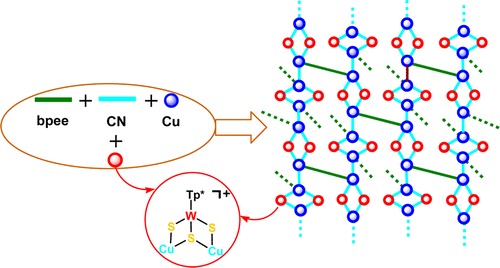Novel [Tp*WS3Cu2]-Based Coordination Compounds: Assembly, Crystal Structures, and Third-Order Nonlinear Optical Properties
Cheng Xu †‡, Zhi-Yuan Zhang †, Zhi-Gang Ren *†(任志刚), Li-Kuan Zhou †, Hong-Xi Li †, Hui-Fang Wang †, Zhen-Rong Sun *§(孙真荣), and Jian-Ping Lang *†‡(郎建平)
† Key Laboratory of Organic Synthesis of Jiangsu Province, College of Chemistry, Chemical Engineering and Materials Science, Soochow University, Suzhou 215123, People’s Republic of China
‡ State Key Laboratory of Organometallic Chemistry, Shanghai Institute of Organic Chemistry, Chinese Academy of Science, Shanghai 200032, People’s Republic of China
§ Department of Physics, East China Normal University, Shanghai 200062, People’s Republic of China
Cryst. Growth Des. 2013, 13, 2530–2539.
Treatment of [Et4N][Tp*WS3] (1) (Tp* = hydridotris(3,5-dimethylpyrazol-1-yl)borate) with [Cu(MeCN)4]PF6 and NH4PF6 (molar ratio = 1:2:1) in excess pyridine (py) produced one discrete trinuclear cluster [Et4N][Tp*WS3Cu2(py)3](PF6)2 (2). Reactions of 1 with [Cu(MeCN)4]PF6, NH4PF6, and 4,4′-bipyridine (4,4′-bipy) (or 1,2-bis(4-pyridyl)ethane (bpea)) (molar ratio = 1:2:1:2) afforded a two-dimensional (2D) [Tp*WS3Cu2]-based cationic polymer {[Tp*WS3Cu2(4,4′-bipy)1.5](PF6)·2MeCN}n (3·2MeCN) and a one-dimensional (1D) [Tp*WS3Cu2]-based cationic polymer {[(Tp*WS3Cu2)2(bpea)3](PF6)2·2DMF}n (4·2DMF), respectively. Analogous reactions of 1 with CuCN, NH4PF6, and 4,4′-bipy (or 1,2-bis(4-pyridyl)ethylene (bpee)) (molar ratio = 1:2:1:2) gave rise to a 2D [Tp*WS3Cu2]-based polymer {[Tp*WS3Cu2(μ-CN)(4,4′-bipy)0.5]·MeCN}n (5·MeCN) and a three-dimensional (3D) [Tp*WS3Cu2]-based anionic polymer {[Et4N][(Tp*WS3Cu2)2{Cu(μ-CN)2.5}2(bpee)]·3MeCN}n (6·3MeCN), respectively. Compounds 2–6 were characterized by elemental analysis, IR, UV–vis, 1H NMR, and single-crystal X-ray diffraction. The cluster cation of 2 has a butterfly-shaped [Tp*WS3Cu2] core structure in which one [Tp*WS3] unit binds two Cu atoms via one μ3-S and two μ-S atoms. 3 consists of one 2D (6,3) network in which butterfly-shaped [Tp*WS3Cu2] units are interlinked by the 4,4′-bipy ligands. 4 contains butterfly-shaped [Tp*WS3Cu2] units that are interconnected by bpea bridges to form one 1D zigzag chain. 5 holds another 2D (6,3) network in which the 1D [{Tp*WS3Cu2}2(μ-CN)2]n chains are bridged by 4,4′-bipy ligands. 6 possesses a 3-connected 3D (103) anionic net in which each 2D [{(Tp*WS3Cu2)2Cu2(μ-CN)4}4(μ-CN)4(bpee)2]n4n– network is interlinked to its neighboring ones via pairs of bpee ligands. The isolation of 2–6 with unstable [Tp*WS3Cu2] cores may be ascribed to the coordination of N-donor ligands or linkers at Cu(I) centers of these cores and the formation of polydimensional [Tp*WS3Cu2]-based frameworks (in the case of 3–5). The third-order nonlinear optical (NLO) properties of 2–6 in DMF were also investigated by using a femtosecond degenerate four-wave mixing (DFWM) technique at 800 nm.

链接: //pubs.acs.org/doi/abs/10.1021/cg400239d